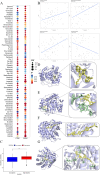Bioinformatics analysis and experimental verification of the cancer-promoting effect of DHODH in clear cell renal cell carcinoma
- PMID: 38796629
- PMCID: PMC11127953
- DOI: 10.1038/s41598-024-62738-0
Bioinformatics analysis and experimental verification of the cancer-promoting effect of DHODH in clear cell renal cell carcinoma
Abstract
Clear cell renal cell carcinoma (ccRCC) is a malignant tumor of the urinary system. To explore the potential mechanisms of DHODH in ccRCC, we analyzed its molecular characteristics using public databases. TCGA pan-cancer dataset was used to analyze DHODH expression in different cancer types and TCGA ccRCC dataset was used to assess differential expression, prognosis correlation, immune infiltration, single-gene, and functional enrichment due to DHODH. The GSCALite and CellMiner databases were employed to explore drugs and perform molecular docking analysis with DHODH. Protein-protein interaction networks and ceRNA regulatory networks of DHODH were constructed using multiple databases. The effect of DHODH on ccRCC was confirmed in vitro. DHODH was highly expressed in ccRCC. Immune infiltration analysis revealed that DHODH may be involved in regulating the infiltration of immunosuppressive cells such as Tregs. Notably, DHODH influenced ccRCC progression by forming regulatory networks with molecules, such as hsa-miR-26b-5p and UMPS and significantly enhanced the malignant characteristics of ccRCC cells. Several drugs, such as lapatinib, silmitasertib, itraconazole, and dasatinib, were sensitive to DHODH expression and exhibited strong molecular binding with it. Thus, DHODH may promote ccRCC progression and is a candidate effective therapeutic target for ccRCC.
Keywords: Apoptosis; Bioinformatics; Clear cell renal cell carcinoma; DHODH; Ferroptosis; Immunotherapy.
© 2024. The Author(s).
Conflict of interest statement
The authors declare no competing interests.
Figures









Similar articles
-
Bioinformatics analysis to disclose shared molecular mechanisms between type-2 diabetes and clear-cell renal-cell carcinoma, and therapeutic indications.Sci Rep. 2024 Aug 19;14(1):19133. doi: 10.1038/s41598-024-69302-w. Sci Rep. 2024. PMID: 39160196 Free PMC article.
-
Construction of circRNA-based ceRNA network to reveal the role of circRNAs in the progression and prognosis of metastatic clear cell renal cell carcinoma.Aging (Albany NY). 2020 Nov 20;12(23):24184-24207. doi: 10.18632/aging.104107. Epub 2020 Nov 20. Aging (Albany NY). 2020. PMID: 33223511 Free PMC article.
-
Comprehensive analysis of ceRNA networks to determine genes related to prognosis, overall survival, and immune infiltration in clear cell renal carcinoma.Comput Biol Med. 2022 Feb;141:105043. doi: 10.1016/j.compbiomed.2021.105043. Epub 2021 Nov 20. Comput Biol Med. 2022. PMID: 34839901
-
Circular RNA hsa_circ_001895 serves as a sponge of microRNA-296-5p to promote clear cell renal cell carcinoma progression by regulating SOX12.Cancer Sci. 2020 Feb;111(2):713-726. doi: 10.1111/cas.14261. Epub 2019 Dec 30. Cancer Sci. 2020. PMID: 31782868 Free PMC article.
-
Molecular mechanism of ferroptosis and its application in the treatment of clear cell renal cell carcinoma.Pathol Res Pract. 2024 Aug;260:155324. doi: 10.1016/j.prp.2024.155324. Epub 2024 Apr 26. Pathol Res Pract. 2024. PMID: 38905897 Review.
Cited by
-
Uridine as a hub in cancer metabolism and RNA biology.Exp Mol Med. 2025 Aug 14. doi: 10.1038/s12276-025-01402-7. Online ahead of print. Exp Mol Med. 2025. PMID: 40804482 Review.
-
KRAS mutation promotes the colonization of Fusobacterium nucleatum in colorectal cancer by down-regulating SERTAD4.J Cell Mol Med. 2024 Oct;28(20):e70182. doi: 10.1111/jcmm.70182. J Cell Mol Med. 2024. PMID: 39462261 Free PMC article.
-
Lapatinib: A Potential Therapeutic Agent for Colon Cancer Targeting Ferroptosis.Anticancer Agents Med Chem. 2025;25(2):114-123. doi: 10.2174/0118715206327756240830062531. Anticancer Agents Med Chem. 2025. PMID: 39238394
References
MeSH terms
Substances
Grants and funding
LinkOut - more resources
Full Text Sources
Medical
Molecular Biology Databases

